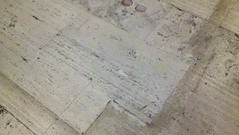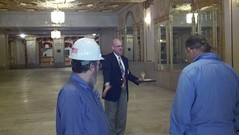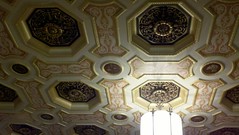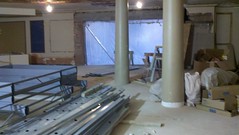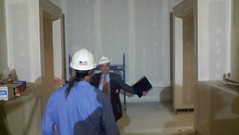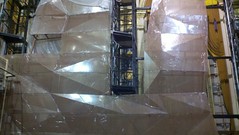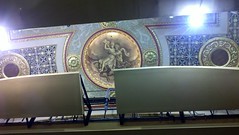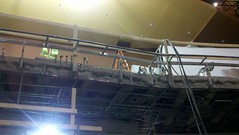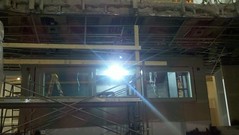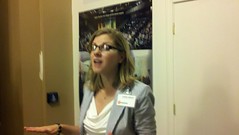Sibelius: Suite from Kuolema
Prokofiev: Classical Symphony (Symphony No. 1), Op. 25
Sasha Makila, conductor.
The Cleveland Orchestra
Borodin: Overture to Prince Igor
Tchaikovsky: Violin Concerto in D major, Op. 35 (Viviane Hagner, violin)
Stravinsky: Scherzo a la russe
David Zinman, conductor.
The Cleveland Orchestra and Kent/Blossom Chamber Orchestra
Mussorgsky: Pictures at an Exhibition (transcribed for Orchestra by Ravel)
David Zinman, conductor.
"What do all great conductors have in common?" one musicians' joke asks. The answer: "They're all dead." While I'm not qualified to apply that label to the decidedly not-dead Mr. Sasha Makila I have thoroughly enjoyed each piece I've had the pleasure of hearing him conduct -- Mr. Makila coaxes a wonderful sound out of the orchestras under his baton. Last week he was gracious enough to answer a few questions via Twitter about this concert (you can find him @sashamakila). Although restricted by Twitter's 140 character limit, I always find it interesting to hear the conductor's thoughts on music. In tonight's concert, for example, he mentioned that while the Prokofiev is "really difficult technically," the Kent/Blossom musicians had not heard the Sibelius before, adding a bit of challenge.
And now we make it to the music: In the Suite from Sibelius's Kuolema (assembled posthumously), the Valise triste was my favorite movement with an elegant feel and happy beginnings, though turning dark towards the ends. The third movement, Canzonetta, felt deeply romantic -- I could almost picture a woman walking down a dark hallway with rose petals for added measure. The fourth and final movement, Valse romantique, mixed with happily chirping birds in the Blossom Pavilion, made me imagine a grand waltz in a garden.
While I enjoyed both of the Kent/Blossom pieces on the program, Prokofiev's Classical Symphony wins by a hair, and covers a range or emotion from a very full-bodied and happy first movement, to a more muted moving second movement -- with an occasional outburst. In the fourth movement-- the note I scribbled in my program was "sharply moving; a chase" -- a moth in the pavilion seemed to be moving with the music: Soaring at the crescendo, then diving as the sound faded.
Following the first intermission, The Cleveland Orchestra, under the baton of David Zinman took over the Blossom Stage with Bordoin's Overture to Prince Igor; the piece had a rather dull opening before seeming to wake a sleeping giant and provoking the full force of the orchestra, if only momentarily.
Christian Tetzlaff had been scheduled to play the solo for Tchaikovsky's Violin Concerto, but "due to travel complications," Vivianne Hagner stepped in to play the same piece in his stead, and with what I understand was very short notice. Unfortunately, this was the least compelling of tonight's program -- the orchestral sections felt restrained, dull, and like it was missing a je ne sais quois (While reading the program note I had a sense of de ja vu -- this piece was last played at Blossom just about a year ago).
In sharp contrast, Stravinsky's Scherzo a la russe (Scherzo in the Russian Style) was lighthearted lively fun, thought the rather abrupt ending was a bit startling. Reading the program note I learned that Stravinsky spent a time in Hollywood during World War II, though all of the projects that he would have composed music for fell through.
Lastly, Ravel's orchestration of Mussorgsky's Pictures at an Exhibition was the second reason for choosing tonight's program over tomorrow's Broadway-inspired program [I was really on the fence!], as that piece at Blossom several years ago was one of the indirect inspirations for this blog. Although I've since found that I prefer Vladmir Ashkenzay's orchestration, the Ravel orchestration played tonight is much more common and well known.
The opening Promenade is a theme that recurs several times throughout the piece though slightly transfigured based on the impressions of the preceding work: Though the opening Promenade with a horn declaration giving way to a firm string statement is my favorite single "movement", the use of this throughout the work to give the sense of the viewer working their way from painting to painting around a gallery contributes to my fondness. Between promenades, of course, are musical representations of the paintings of Viktor Hartmann. Every time I hear Pictures at an Exhibition, those representations seem more coherent and it's easier to pick out the underlying painting: Tonight, for example, the lumbering polish Ox cart quietly and slowly approaching, gaining full focus (with the full orchestra) then quietly disappearing over the horizon had new found clarity. Likewise, Lemoges le marche (La grand nouvelle), took on a new dimension of gossip and excitement, hustle and bustle of an open market.
Lincoln



 For the past two days I've been pretty much nonfunctional -- I suspect it's the final vestages what I had a few weeks back rearing its ugly head. The good news is that by this afternoon the headache had receeded to the point where I felt like a mostly functional member of society, and it was none too soon as I've been looking forward to tours of the Cleveland Play House's new theatres and I just barely made it. (And I failed completely to remember to ask Mr. Bloom or Mr. Moore the programming-related questions I intended to ask)
For the past two days I've been pretty much nonfunctional -- I suspect it's the final vestages what I had a few weeks back rearing its ugly head. The good news is that by this afternoon the headache had receeded to the point where I felt like a mostly functional member of society, and it was none too soon as I've been looking forward to tours of the Cleveland Play House's new theatres and I just barely made it. (And I failed completely to remember to ask Mr. Bloom or Mr. Moore the programming-related questions I intended to ask)